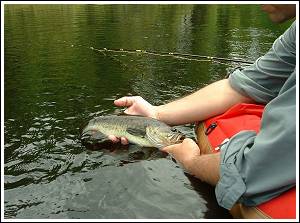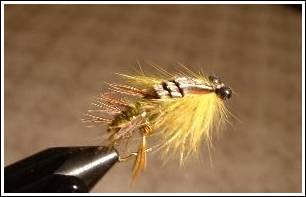|
Breathing Dragon
By Jason Akl
Contrary to popular belief, largemouth bass do not feed entirely on minnows, frogs and crayfish. Most tackle stores have aisles upon aisles of poppers, crank baits and spinners made to imitate these larger food sources while never paying much attention to the smaller aquatic insects that also inhabit these waters. These tasty little critters make up a large portion of the largemouth's respective diet during the summer months.

Dragon flies are important members of lake and pond ecosystems. Dragon fly nymphs are large in size and often occur in great numbers in these fertile locations. For all intensive purposes these critters basically crawl around the bottom or near underwater structure eating everything they get can get there jaws into, leaving them atop the food chain for aquatic insects but at the bottom in a fish's world.
Dragon flies swim with a special technique that can be compared to a simple form of jet propulsion. This process of expelling water causes the real nymph to shoot forward in an irregular fashion while swimming. For fly anglers this irregular swimming action is the key to catching those large mouthed lunkers. When using dragon fly patterns such as the breathing dragon alternate the retrieve between quick strips and short pauses. This retrieve will make the fibers used to construct this fly pattern to pulse and pump as it is stripped through the water mimicking the true action displayed by these bugs in the water.

The breathing dragon has been a work in progress for the last two or so summers. Slaying bass, blue gill, trout or whatever seems to cross its path. This pattern has developed from the traditional stream fishing trout nymph to a critter that works it magic between the lilies and logs of our favorite bass lakes.
Materials Used in the Breathing Dragon
Hook: TMC 200R size 4
Thread: Uni-thread Olive size 8/0
Body: Larval Lace Olive/ Pheasant Tail Fibers
Shellback: 3 Pheasant Body Feathers
Thorax: Olive Zonker Fur
Eyes: Black Bead Chain Eyes
Legs: Pheasant Tail Fibers Knotted
Antennae: Stripped Grizzly Hackles
Underbody: Green Dubbing

1. Start this fly by placing the hook into the vice securely and attaching the thread to the hook shank. Clip two 3 inch pieces of olive larval lace and attach them securely to the top of the hook shank. Cover these two pieces of lace with thread until you hit the bend in the hook shank. Pinch dub the thread with the olive dubbing and build a large thick underbody extending to the 1/2 mark on the hook shank. Start building the lace body of the fly using the grandma weave technique, tow weave to start then stop. In front of these two weaves tie in 4-6 peasant tail fibers that extend off the back of the fly approximately a quarter of an inch. Using the grandma weave technique again start weaving the body around these pheasant tail fibers

2. Repeat this process of two weaves then tie in pheasant tail fibers until you reach the end of the dubbed body.

3. Fix three pheasant body feathers and allow them to dry thoroughly. Tie in the fixed feather by it tip so that the feather leans over the rear end of the fly. In front of this tie in point wrap down two pheasant tail legs and form a dubbing loop with the thread. Insert some olive zonker fur into the dubbing loop and spin the fur into a nice thick hackle. Wrap this fur hackle up the body of the fly, sweeping all the fibers backwards with your fingertips. Bring the fixed feather forward over the fur hackle body and tie it off. Repeat this process two more times omitting the pheasant tail fiber legs. Before you bring forward the third fixed feather tie in pair of black bead chain eyes.

4. Make one final fur hackle and wrap it to the back of the bed chain eyes. Now bring the third fixed feather forward over the eyes and tie it off securely in-front and behind the eyes. Clip the excess feather and whip finish the thread and cement the head.
All text
and photos by
Jason Akl © 2005 |